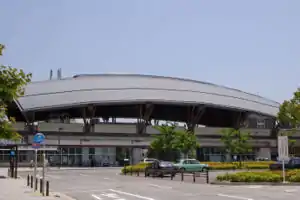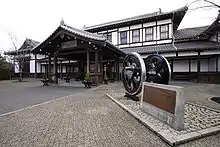Nijō Station (Kyoto)
Nijō Station (二条駅, Nijō-eki) is a train station in Nakagyō-ku, Kyoto, Japan.
Nijō Station 二条駅 | |
|---|---|
| Location | Nishinokyo Toganoocho, Nakagyō, Kyoto, Kyoto (京都市中京区西ノ京栂尾町) Japan |
| Operated by | |
| Connections |
|
Lines
- West Japan Railway Company (JR West)
- Kyoto Municipal Subway
- Tōzai Line (Station Number: T15)
Layout
JR West
Nijō Station 二条駅 | |
|---|---|
| JR West station | |
 Nijō Station, May 2006 | |
| Location | 3, Nishinokyo Toganoocho, Nakagyō, Kyoto, Kyoto (京都市中京区西ノ京栂尾町3) Japan |
| Coordinates | 35°0′39.51″N 135°44′30.1″E |
| Operated by | West Japan Railway Company |
| Line(s) | Sanin Main Line (Sagano Line) |
| History | |
| Opened | 1897 |
| Passengers | |
| FY2015 | 26,415 daily[1] |
The station has one elevated island platform between two tracks. The station building was designed by Urabesekkei, an architectural firm based in Osaka. Prior to the platform elevation, the station was only accessible from the east (Sembon Street side), but the station renovation made it accessible from both the east and west sides.
The design elements of the former station building were evocative of nearby Nijō Castle. The building was dismantled and rebuilt at the Kyoto Railway Museum (then called the Umekoji Steam Locomotive Museum) in 1996.
| 1 | ■ Sagano Line | for Kyoto |
| 2 | ■ Sagano Line | for Kameoka, Sonobe and Fukuchiyama |

Kyoto Subway
Nijō Station 二条駅 | |
|---|---|
| Kyoto Municipal Subway station | |
| Location | 3, Nishinokyo Toganoocho, Nakagyō, Kyoto, Kyoto (京都市中京区西ノ京栂尾町3) Japan |
| Coordinates | 35°0′42.76″N 135°44′28.73″E |
| Operated by | Kyoto Municipal Subway |
| Line(s) | Tōzai Line |
| Other information | |
| Station code | T15 |
| History | |
| Opened | 1997 |
| Passengers | |
| FY2016 | 19,471 daily[2] |
Subway station has one underground island platform with two tracks, separated by platform screen doors.
| 1 | ■ Tōzai Line | for Uzumasa Tenjingawa |
| 2 | ■ Tōzai Line | for Karasuma Oike, Rokujizo and Hamaotsu |
History
Nijō Station opened on February 15, 1897 and was the terminus of the Kyoto Railway (present-day San'in Main Line) until April 27 of the same year.[3] The original station building was moved to its current location at the Kyoto Railway Museum on April 1, 1996.[4] The Tōzai Line subway opened on October 12, 1997. The Tōzai line was extended to the Uzumasa Tenjingawa Station on January 16, 2008.[5]
Ridership
| Year | Boarding Passengers | Arriving Passengers | Total |
|---|---|---|---|
| 2013 | 8,802 | 8,364 | 17,166 |
| 2014 | 9,202 | 8,745 | 17,947 |
| 2015 | 9,624 | 9,143 | 18,767 |
| 2016 | 9,985 | 9,486 | 19,471 |
| 2017 | 10,281 | 9,767 | 20,048 |
Surrounding area
East Side
The Shinsenen and the Nijō Castle are within walking distance, however in case of traveling via subway, the adjacent station of Nijōjō-mae is closer.
- Ritsumeikan University Nijō Campus.
- Bukkyo University Nijō Campus.
- Senbon Street
- Life Supermarket Nijo Station Store
West Side
- BiVi Nijō.
Buses
Nijo-eki-nishiguchi
- Kyoto City Bus
- Route 66 for Katsura-eki-higashiguchi
- Airport limousine
- for Osaka International Airport (Osaka Airport Transport Co., Ltd.)
- for Kansai International Airport (Kansai Airport Transportation Enterprise Co., Ltd.)
Nijo-ekimae
- Kyoto City Bus
- Route 6 for Shijo Omiya / for Bukkyo University and Gentaku
- Route 15 for Shijo Kawaramachi and Sanjo Keihan via Oike Street / for Emmachi and Ritsumeikan University
- Route 46 for Gion and Heian Shrine / for Kamigamo Shrine via Sembon Street
- Route 55 for Shijo Omiya and Shijo Karasuma / for Kitano Tenman-gu and Ritsumeikan University
- Route 66 for Katsura-eki-higashiguchi / for Nijo-eki-nishiguchi
- Route 201 for Mibu and Gion / for Sembon Imadegawa and Hyakuman-ben
- Route 206 for Nanajo Omiya and Kyoto Station / for Sembon Kitaoji and Kitaoji Bus Terminal
- Rapid buses for Bukkyo University / Rapid buses for Ritsumeikan University
- Kyoto Bus Co., Ltd.
- Route 61 for Arashiyama and Daikaku-ji via Marutamachi Street and Kyoto Studio Park / for Sanjo Keihan via Shijo Kawaramachi
- Route 62 for Arashiyama and Kiyotaki via Marutamachi Street and Kyoto Studio Park / for Sanjo Keihan via Horikawa Oike (Nijo Castle), Karasuma Oike and Shijo Kawaramachi
- Route 63 for Arashiyama, Koke-dera and Suzumushi-dera via Marutamachi Street and Kyoto Studio Park / for Sanjo Keihan via Shijo Kawaramachi
- Route 65 for Arashiyama and Arisugawa via Marutamachi Street and Kyoto Studio Park
- West JR Bus Company
- for Kyoto Station / for Toganoo and Shuzan
Adjacent stations
| « | Service | » | ||
|---|---|---|---|---|
| West Japan Railway Company Sagano Line (Sanin Main Line) | ||||
| Tambaguchi | Local | Emmachi | ||
| Kyoto | Rapid | Emmachi | ||
| Kyoto Municipal Subway Tōzai Line (T15) | ||||
| Nijōjō-mae (T14) | - | Nishiōji Oike (T16) | ||
References
- "Archived copy" 鉄道乗車人員 (in Japanese). Kyoto Prefecture. Archived from the original on 2015-07-12. Retrieved 2017-12-17.CS1 maint: archived copy as title (link)
- 京都市交通事業白書 (in Japanese). Kyoto Municipal Transportation Bureau.
- Ishino, Tetsu; et al., eds. (1998). 停車場変遷大事典 国鉄・JR編 [Station Transition Directory - JNR/JR] (in Japanese). II. Tokyo: JTB Corporation. p. 298. ISBN 4533029809.
- "京都新聞|京都鉄道博物館 - (21)旧二条駅舎". www.kyoto-np.co.jp. Retrieved 2019-04-17.
- "京都市交通局:地下鉄東西線二条~太秦天神川間が1月16日に延伸開業". www.city.kyoto.lg.jp. Retrieved 2019-04-17.
- "京都市交通事業白書(事業概要)" (PDF). 京都市交通局. 2017.
External links
| Wikimedia Commons has media related to Nijō Station (Kyoto). |
- (in Japanese) Nijō Station page from JR West website
- (in Japanese) Nijō Station page from Kyoto city website